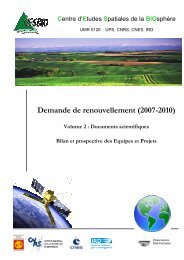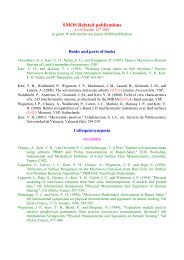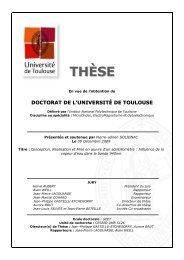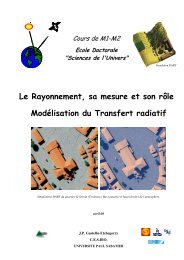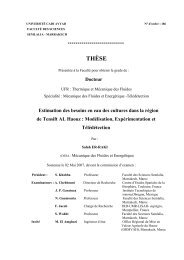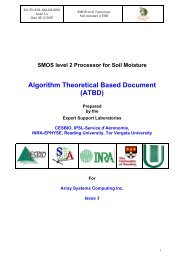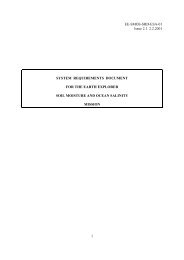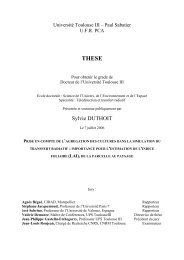Chapitre 3. Article 122∆ 2δShv+ δ Svv2δShv+ δ Svvδ δAco=≤= 2 +− polSSb ahhhh2≤ 1.43δ+ 2.5δWhen |δ| equals -30dB, ∆A co-pol is lower than 4.8%, which would lead to a maximumbackscatter perturbation of 0.4dB. A co-polarized intensity ratio could be offset by amaximum value of 0.8dB in the worst case. The corresponding additional error can be read onFigure 7 with |d|=0.8dB, and is lower than 4% when ∆r>4%. The effect of cross-talk istherefore relatively negligible in co-polarized channels.In cross-polarized channels, the percent perturbation in amplitude is:22δShh+ δSvv+ δ Shv δ Shh+ δ Svv+ δ Shv∆Across− pol=≤= δ cSShvhv( b + )+ δ22≤ 8δ+ δWhen |δ| equals -30dB, ∆A cross-pol can reach 26%, which could lead to a backscatterperturbation as high as 2dB. The intensity ratio of one co-polarized channel and one crosspolarizedchannel can therefore be around 2.4dB in unfavourable cases, and up to 4dB for atemporal ratio of cross-polarized intensities. The use of cross-polarizations in intensity ratiosshould therefore be subject to very severe requirements on cross-talk. For example, a crosstalkvalue lower than -40dB would guarantee that the backscatter perturbation is lower than0.6dB for cross-polarizations.In conclusion, in classification methods based on an intensity ratio, cross-talk does not seemto be an issue as long as only co-polarizations are dealt with. However, how expected, it maybe very critical when cross-polarizations are involved.IV. IMPACT OF OTHER SYSTEM PARAMETERSApart from calibration parameters, other mission and system parameters (satellite repeatcycle, spatial resolution, ambiguity ratio) can affect the classification accuracy, but their effectcannot be assessed in the general case. They have to be considered together with applicationspecificand scene-specific parameters, for example the temporal backscattering profile of thetwo classes when dealing with multitemporal ratios, the presence of targets with highbackscatter that would maximize error due to ambiguity, or the typical size of patches.A. Impact of ambiguityAmbiguity is a form of ghosting that happens when bright targets are illuminated by the sidelobes of the SAR antenna and contaminate the backscattering return attributed toneighbouring areas illuminated by the main lobe. Range ambiguity occurs from ambiguouszones whose slant range differs from that of the desired zone by non-zero multiples of thepulse repetition distance, and whose Doppler frequencies differ by multiples of the pulserepetition frequency (PRF) [25]. Azimuth ambiguity is caused by zones whose slant rangesare the same as the desired zone, but whose Doppler frequencies differ by multiples of thePRF [25]. The distributed target ambiguity ratio is the ratio of the unwanted ambiguousintensity to the wanted target intensity, taking into account both range and azimuth ambiguity.Typical values range from -17 dB to -40 dB.The impact of ambiguity may be expressed in the following terms. With an ambiguity rationoted a, the measured complex amplitude S a relates to the complex amplitude of the observedscene S 0 and to the complex amplitude of the scene at the source of the ambiguity S s by thefollowing relationship:Sa= S 0+ aS s(21)The relationship equivalent to (21) for the backscatter intensity is retrieved using (18):285
Chapitre 3. Article 12 2IaK S0 + aSs+ 2 aS0Ss≤ I0+ aIs+ 2 aI0= I (22)Ambiguities increase the measured backscatter, and the effect is more important when thebackscatter of the ambiguous area is high compared to the backscatter of the observed area.Therefore, the change in backscatter is the most critical when the source of the ambiguity isthe brightest elements in the scene, e.g. built up areas.To quantify the impact of ambiguity on the classification performance, one has to assess thechanges in the class parameters r A and r B that are caused by the ambiguity. For that purpose,the original backscatter values I 1 and I 2 composing the intensity ratio r=I 2 /I 1 need to be knownfor the two classes. For simplicity, we suppose here that r A =0dB, so I 1,A =I 2,A . This is quiterealistic for the TC method (class A being usually assumed stable in time), and for the PRmethod in the case of a ratio of co-polarized intensities (co-polarizations being of the sameorder of magnitude in many natural targets).Under this assumption, the backscatter increase due to ambiguity is the same in I 1,A and I 2,Aand r A remains equal to 0dB. The backscatter values of class B are I 1,B and I 2,B =(I 1,B +∆r)dB.The effect of ambiguity on I 1,B and I 2,B is calculated from (22). We simulate here the worstcase, when the ambiguous source is an urban area and when the ambiguous backscatter equalsthe right-hand side of the inequality in (22). The default backscattering value taken for urbanareas is I s= 0dBat any date and polarization. The modified values of I 1,B and I 2,B lead to amodified intensity ratio r B and to a new value of the ∆r parameter, noted ∆r a .Figure 6 shows the value of the class separability with ambiguity (∆r a ) as a function of theambiguity ratio (a), for several values of I 1,B and for an initial class separability ∆r=8dB. Asexpected, the effect of ambiguities is higher when class B has low backscatter values. WhenI 1,B =-16dB, ∆r a can decrease below 5dB in extreme cases (a=-17dB).sEffect of ambiguity on ∆r a876∆r a(dB)54I 1,B=-16dB3-14dB-12dB2 -10dB-8dB1 -6dB-4dB0-40 -35 -30 -25 -20 -15Ambiguity ratio (dB)Figure 6. Effect of Ambiguity level a on ∆r a with several values of I 1,B .The reduction in ∆r a leads to an increase of the classification error. Figures 7 shows the effectof ambiguity ratio on the additional classification error due to ambiguity for the case whenI 1,B =-10dB, ∆r=8dB and p(B)=0.5, for several numbers of looks L. For the worst case of anambiguity ratio equal to -17 dB, the additional error is higher than 4% for a low number oflooks (L




